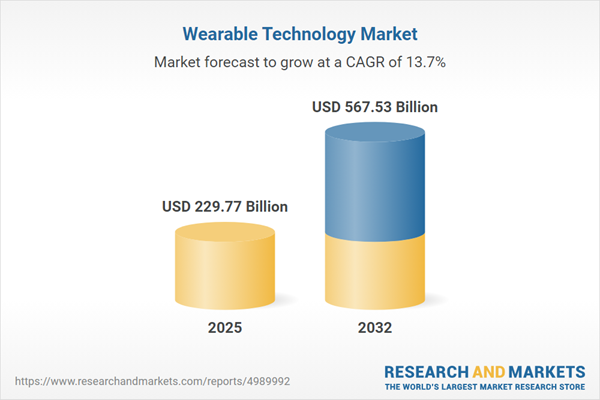Speak directly to the analyst to clarify any post sales queries you may have.
Enterprise wearable technology is reshaping how organizations manage productivity, safety, and agility in the digital enterprise era. With growing adoption across industries, connected wearable devices are becoming essential tools for supporting operational excellence, compliance readiness, and workforce engagement.
Market Snapshot: Wearable Technology Market
The global wearable technology market is projected to experience strong growth, rising from USD 203.14 billion in 2024 to USD 229.77 billion in 2025, and forecast to reach USD 567.53 billion by 2032, reflecting a compound annual growth rate of 13.70%. This expansion is propelled by innovation in asset tracking, workforce management, and tailored applications in manufacturing and healthcare. Enterprises utilizing connected wearables are unlocking efficiency gains through analytics-driven automation, enhanced compliance, and the ability to adapt swiftly to regulatory changes. These advances facilitate effective decision-making and help organizations keep pace with evolving digital priorities.
Scope & Segmentation: Enterprise Wearable Technology Landscape
- Device Types: Fitness trackers provide employees with continuous health monitoring; hearables enable real-time team communication; smart clothing gathers biometric and environmental insights; smart eyewear allows hands-free functionality for field teams; smartwatches facilitate oversight of workforce activities.
- Component Innovation: High-capacity batteries extend operational uptime for devices; secure connectivity modules ensure seamless integration with IT systems; advanced display technology delivers operational visibility; rapid processors support instant analytics; integrated sensors promote workplace safety and support regulatory compliance.
- End Users: Employees benefit from tailored well-being updates; businesses streamline asset tracking and regulatory tasks; healthcare professionals remotely monitor patient status; sports and fitness experts apply analytics for safety and performance improvement.
- Applications: Health tracking strengthens workforce engagement; industrial teams focus on hazard prevention; sector-specific monitoring enables targeted responses; fitness-based analytics inform employee wellness initiatives; collaborative platforms drive team training and productivity.
- Distribution Channels: Direct sales, retail partners, online platforms, and manufacturer portals ensure rapid enterprise access and scalability for wearable solutions.
- Regional Markets: The Americas emphasize automation; Europe prioritizes regulatory compliance; Asia-Pacific advances rapid adoption of new technologies; the Middle East and Africa adapt wearable solutions to local infrastructure and investment trends.
- Leading Players: Apple Inc., Xiaomi Corporation, Samsung Electronics, Huawei Technologies, Google LLC, Garmin Ltd., Zepp Health Corporation, OPPO, Realme, and Fossil Group drive product development and supply chain resilience within the sector.
Key Takeaways for Senior Decision Makers
- Wearable devices grant actionable insights into assets and personnel, supporting responsive management in dispersed, dynamic business environments.
- Integrating advanced sensors and robust batteries ensures round-the-clock operational monitoring while contributing to organizational efficiency.
- Embedding wearable technologies in daily workflows clarifies compliance steps, shortens reporting cycles, and reduces exposure to business risks.
- Interoperability with enterprise and healthcare platforms automates key processes, aligning productivity goals with employee wellness strategies.
- Elevated standards for governance and privacy help maintain compliance and safeguard organizational reputation in global markets.
- Comprehensive technical and post-sales support fosters enduring client confidence and adaptation amid shifting competitive landscapes.
Tariff Impact: Navigating US Policy Shifts
Fluctuating US trade policies prompt wearable technology organizations to reinforce supply chain strategies and evaluate diversified manufacturing options. Consistent engagement with regulatory authorities strengthens risk management, securing access to components such as batteries and advanced displays. These measures support operational continuity despite evolving policy environments.
Methodology & Data Sources
This analysis draws on executive interviews, technical documentation, patent reviews, financial analysis, and current regulatory updates. Using a diverse range of data sources equips decision makers with a transparent and independent perspective on enterprise wearable technology adoption and emerging best practices.
Why This Report Matters
- Senior leaders gain a practical resource to align digital transformation objectives with enterprise wearable technology advancements for stronger business outcomes.
- Relevant market intelligence enables navigation of changing regulations, evolving supply chains, and shifting operational demands.
- Unbiased forecasts provide a reliable foundation for long-term resilience and informed strategic planning.
Conclusion
This report equips leadership teams to strengthen operational performance, support resilient business models, and pursue new opportunities through enterprise wearable technology adoption.
Additional Product Information:
- Purchase of this report includes 1 year online access with quarterly updates.
- This report can be updated on request. Please contact our Customer Experience team using the Ask a Question widget on our website.
Table of Contents
3. Executive Summary
4. Market Overview
7. Cumulative Impact of Artificial Intelligence 2025
List of Figures
Companies Mentioned
The companies profiled in this Wearable Technology market report include:- Apple Inc.
- Xiaomi Corporation
- Samsung Electronics Co., Ltd.
- Huawei Technologies Co., Ltd.
- Google LLC
- Garmin Ltd.
- Zepp Health Corporation
- Shenzhen OPPO Mobile Telecommunications Corp., Ltd.
- Realme Technology (Shenzhen) Co., Ltd.
- Fossil Group, Inc.
Table Information
| Report Attribute | Details |
|---|---|
| No. of Pages | 180 |
| Published | November 2025 |
| Forecast Period | 2025 - 2032 |
| Estimated Market Value ( USD | $ 229.77 Billion |
| Forecasted Market Value ( USD | $ 567.53 Billion |
| Compound Annual Growth Rate | 13.7% |
| Regions Covered | Global |
| No. of Companies Mentioned | 11 |









